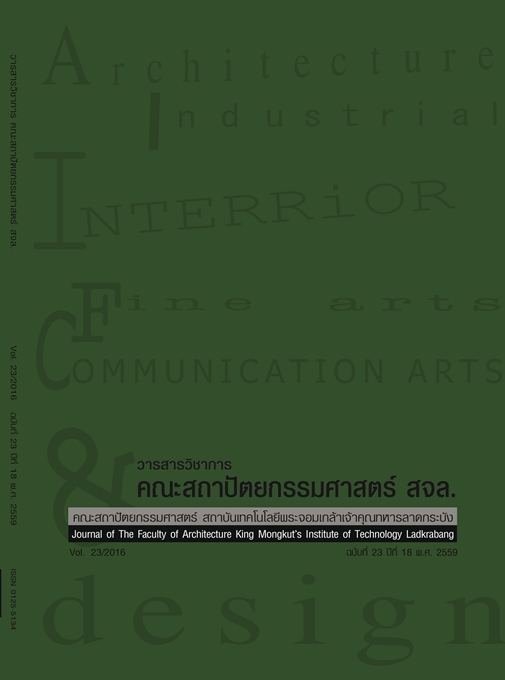แนวทางการพัฒนาตลาดสดสีเขียวรังสิต (The Development Guidelines for Rangsit Green Fresh Market)
Main Article Content
Abstract
บทคัดย่อ
ตลาดสดรังสิตเป็นส่วนหนึ่งของศูนย์การค้าตลาดรังสิต ที่ให้บริการกับชุมชนรังสิตมามากกว่า 50 ปี และมีการพัฒนาอย่างต่อเนื่องจากโครงการตลาดสดน่าซื้อในปี พ.ศ. 2546 ตามนโยบายกรมอนามัย กระทรวงสาธารณสุข มุ่งเน้นความปลอดภัยด้านอาหารจากกลุ่มผู้ประกอบการกว่า 400 แผง และรณรงค์สร้างความเชื่อมั่นให้กับประชาชนผู้บริโภคโดยสามารถปฎิบัติได้ครบตามมาตรฐานตลาดสดน่าซื้อระดับ 5 ดาวกว่า 10 ปีติดต่อกัน ประกอบกับปัจจุบันกลุ่มผู้บริโภคได้ให้ความสำคัญด้านสุขภาพและสิ่งแวดล้อมมากยิ่งขึ้น การให้ความสำคัญถึงความเป็นธุรกิจแนวคิดด้านการตลาดเพื่อสังคม (Social Marketing
Concept) และแนวคิดความรับผิดชอบต่อสังคมของธุรกิจ (CSR) ก็ถูกนำมาปรับใช้ในตลาดสดรังสิตมากขึ้นเป็นลำดับสอดคล้องกับงานด้านสถาปัตยกรรมเพื่อสิ่งแวดล้อมที่ได้ถูกพัฒนาหลักการออกแบบสถาปัตยกรรมสีเขียว (Green Architecture)ซึ่งได้ถูกนำมาใช้เป็นเกณฑ์ประเมินอาคารของสถาบันอาคารเขียวไทย (TGBI) ในปัจจุบันเช่นกัน
การวิจัยนี้จึงมีเป้าประสงค์เพื่อทดสอบและยกระดับมาตรฐานตลาดสดจากเกณฑ์ในการประเมินด้านสาธารณสุข (ตลาดสดน่าซื้อ) ให้พิจารณาในด้านสถาปัตยกรรมและสิ่งแวดล้อมมากยิ่งขึ้น ซึ่งการศึกษานี้เป็นทั้งการวิจัยเชิงปริมาณและเชิงคุณภาพควบคู่กัน รวมถึงเป็นการวิจัยที่มุ่งเน้นการนำไปใช้ประโยชน์จริงทั้งในด้านนโยบายระยะยาวและการแก้ปัญหาระยะสั้นด้านกายภาพ (Action Research) โดยทำการประเมินจากผู้มีส่วนได้ส่วนเสีย 3 กลุ่มคือ กลุ่มตัวแทนผู้บริโภคจำนวน400 ตัวอย่าง กลุ่มตัวแทนผู้ประกอบการขายทั้ง 13 กลุ่มสินค้าจำนวน 40 ร้าน และ ประเมินในระดับการนำไปใช้สุดท้าย
โดยผู้จัดการตลาดและทีมบริหารงาน
ผลการวิจัยพบว่า การสัญจรทางรถรอบตลาดสดมีการจราจรหนาแน่นโดยเฉพาะวันกิจกรรมตลาดนัด ส่งผลต่อความพอใจในการมาซื้อสินค้าซึ่งแก้ไขจากการเพิ่มจำนวนที่จอดรถบริเวณตลาดเก่าเดิม รวมถึงลดจุดตัดทางแยกและเพิ่มช่องทางรถเดินทางเดียว ในด้านการตลาดสีเขียว (Green Marketing) กลุ่มผู้มีส่วนได้ส่วนเสียทั้ง 3 กลุ่ม และการสรุปผลในที่ประชุมกลุ่มผู้บริหารงาน มีแนวคิดการพัฒนาตรงกัน คือ การใช้บรรจุภัณฑ์รีไซเคิล ลดการใช้ทรัพยากรฟุ่มเฟือย ขายเศษส่วนที่เหลือเป็นอาหารสัตว์ การนำสินค้าที่ใช้พลังงานในการผลิตน้อยในราคาต้นทุนต่ำมาขาย และการประชาสัมพันธ์คุณภาพผลิตภัณฑ์ต่อผู้บริโภคและสุขภาพอันเกิดจากพฤติกรรมการเคลื่อนไหวบนแผงค้าตามลำดับขั้นตอนซื้อขายมีองค์ประกอบแผงที่เหมาะสมคือ ระยะเอื้อมส่งของ 0.90-1.20 เมตร สูง 0.75-0.80 เมตร
ส่วนในด้านสถาปัตยกรรมและสิ่งแวดล้อมทั้ง 8 ด้านพบว่ามีเป้าหมาย 13 ข้อ และบางข้อได้รับการแก้ไขแล้ว คือการสร้างช่องทางรับฟังเพิ่มเติม เพิ่มประสิทธิภาพการจราจร เพิ่มต้นไม้และภูมิทัศน์ เพิ่มจำนวนอ่างล้างจานล้างมือ ติดตั้งฉนวนใต้หลังคา ปรับเปลี่ยนวัสดุพื้นทางเดินในตลาดสด เพิ่มช่องระบายอากาศใต้หลังคา เน้นจัดระเบียบการวางสินค้า สร้างทางลาดเพื่อคนชราและคนพิการ จัดพื้นที่สูบบุหรี่ คัดแยกขยะ 3 ประเภท จัดระเบียบจุดรวมขยะ และสนับสนุนประดิษฐกรรมชาวบ้านเพื่อใช้ในแผงค้า โดยในการณ์นี้แนวทางการประเมินตลาดสดจากการรวมเกณฑ์ด้านสาธารณสุข (ตลาดสดน่าซื้อ) และเกณฑ์
อาคารเขียวในแบบสอบถามผู้ประกอบการจะถูกนำมาพิจารณามากขึ้นในการตรวจประเมินโอกาสต่อไป
คำสำคัญ: ตลาดสดสีเขียว ตลาดวิถีไทย การพัฒนาชุมชนอย่างมีส่วนร่วม ทัศนคติชุมชนและผู้ประกอบ
การ
Abstract
Rangsit fresh market is a part of Rangsit market hall, which has provided services for community around Rangsit area for more than fifty years. This market has been continually developed from Healthy Market
Project since 2003 according to the policy of Department of Health, Ministry of Public Health. The Health Market Project focused on food safety from more than 400 retailers and promoting the campaign to make the reliance from the customer. This project continually reached the achievement on 5 stars Healthy Market standard more than 10 years. Currently, the customers have more concerned with their health and environment.
In addition, concept of social marketing and Corporate Social Responsibility (CSR) have been applied in implementation of Rangsit market. These factors conform to the concept of environmental-concerned architecture,which has been developed design principle as “Green Architecture.” At present, Thai Green Building Institute (TGBI) also uses the same criteria to evaluate the building in Thailand.
This research aims to evaluate and improve the fresh market standard from public health aspect (Healthy Market) to take more the architectural design and environment concerned into consideration. This study not only is the quantitative research, but also is the qualitative research as well. It emphasized on implementation on improving physical problem in short-term and setting up the strategic policy in long-term. The main 3 groups of stakeholders, which have been evaluated by questionnaires, are 400 representatives of consumers, 40 representatives from 13 groups of retailers, a market manager and administrative officers.
As a result, the overcrowd road traffic and circulation around the market especially on occasional market is the main factor impact to customers’ satisfaction. The proposed solution is the traffic management
which covers following measures: increasing the number parking lots in the area of old market, reducing the cross way traffic and rearrange the one-way traffic.
According to the green marketing aspect, three groups of stakeholders and the administrative office meet the agreement on supporting the recycle package use in the market, reducing the over resource utilization,
selling organic waste to animal feed manufacturer, supporting and promoting the low-cost and less-energy products. To promote and improve the healthy behavior for sellers, this study proposed the suitable reach out
arm dimension for stall design related to the human dimension and ergonomics, which are the 0.90-1.20 meters long and 0.75-0.80 meters high.
Following to the eight aspects of the architectural and environmental, there are 13 objectives, some of them have been resolved including the public hearing mechanism, improving of traffic system and landscaping,
increasing the number of washbasins, installing the thermal insulation under the roof, changing the pavement in fresh market, increasing the number of air passages, reorganizing the stall, providing ramp for disable and elderly, providing the smoking area, waste sorting (3 kinds) and organizing the solid waste collecting area, and supporting the community product and invention. The guidelines on fresh market evaluation system, which combine the public heath criteria for Healthy Market and the evaluation criteria on green building, will be taken into more consideration in the next assessment.
Keywords: Green Fresh Market Thai Cultural Market
User Participation Community Development
Community and Entrepreneur Attitude
Article Details
This work is licensed under a Creative Commons Attribution-NonCommercial-ShareAlike 4.0 International License.
Copyright Transfer Statement
The copyright of this article is transferred to Journal of The Faculty of Architecture King Mongkut's Institute of Technology Ladkrabang with effect if and when the article is accepted for publication. The copyright transfer covers the exclusive right to reproduce and distribute the article, including reprints, translations, photographic reproductions, electronic form (offline, online) or any other reproductions of similar nature.
The author warrants that this contribution is original and that he/she has full power to make this grant. The author signs for and accepts responsibility for releasing this material on behalf of any and all co-authors.


